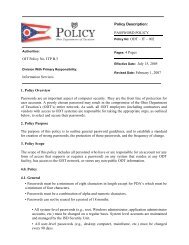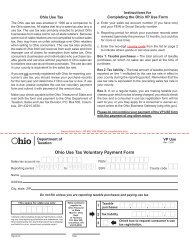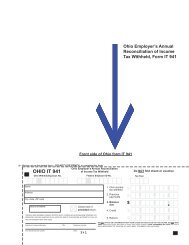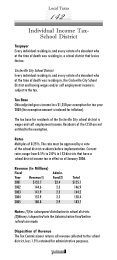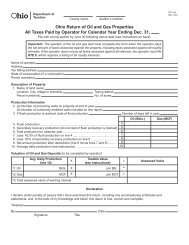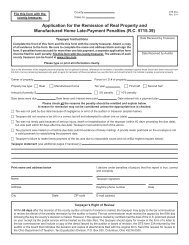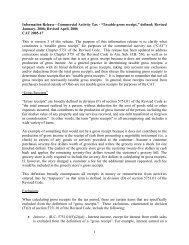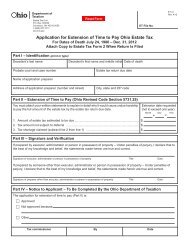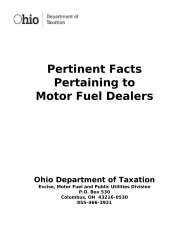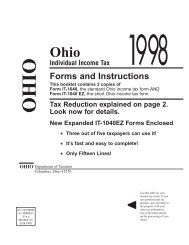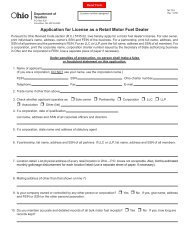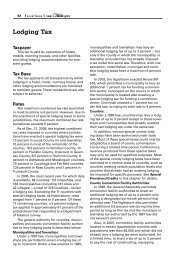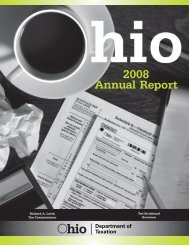Worksheet to Calculate Revenue for Form DTE 140R When a ...
Worksheet to Calculate Revenue for Form DTE 140R When a ...
Worksheet to Calculate Revenue for Form DTE 140R When a ...
Create successful ePaper yourself
Turn your PDF publications into a flip-book with our unique Google optimized e-Paper software.
<strong>Worksheet</strong> <strong>to</strong> <strong>Calculate</strong> <strong>Revenue</strong> <strong>for</strong> <strong>Form</strong> <strong>DTE</strong> <strong>140R</strong><br />
<strong>When</strong> a Taxing Authority Certifies a Rate and Requests the <strong>Revenue</strong><br />
Produced by that Rate <strong>for</strong> Renewal With an Increase Levies<br />
Calculation of <strong>Revenue</strong><br />
Current Rate Increase Tax Value <strong>Revenue</strong><br />
1. Class I Real – Res/Ag ( ____ . ____ + ___ . ___ ) X $____________ ÷ 1000 = $ _____________<br />
2. Class II Real – Other ( ____ . ____ + ___ . ___ ) X $____________ ÷ 1000 = $ _____________<br />
3. Public Utility Personal ( ____ . ____ + ___ . ___ ) X $____________ ÷ 1000 = $ _____________<br />
4. General Personal ( ____ . ____ + ___ . ___ ) X $____________ ÷ 1000 = $ _____________<br />
5. Personal Property Phase-out Reimbursement Payment $ _____________<br />
6. Total <strong>Revenue</strong> $ _____________<br />
Instructions<br />
Line 1. Under “current rate,” enter the existing effective tax rate in mills <strong>for</strong> Class I. Under “increase,” enter the<br />
requested gross increase rate in mills. Enter tax valuation of all class I real property (residential and agricultural<br />
property) included on the tax list most recently certified <strong>for</strong> collection. Multiply the sum of the current rate and<br />
increase rate times the tax value, then divide by 1,000 <strong>to</strong> get tax revenue in dollars.<br />
Line 2. Under “current rate,” enter the existing effective tax rate in mills <strong>for</strong> Class II. Under “increase,” enter the<br />
requested gross increase rate in mills. Enter tax valuation of all Class II real property (all other real property)<br />
included on the tax list most recently certified <strong>for</strong> collection. Multiply the sum of the current rate and increase rate<br />
times the tax value, then divide by 1,000 <strong>to</strong> get tax revenue in dollars.<br />
Line 3. Under “current rate,” enter the existing gross tax rate in mills. Under “increase,” enter the requested gross<br />
increase rate in mills. Enter the estimated valuation of public utility personal property <strong>for</strong> the first tax year the levy<br />
will be assessed against public utility personal property. To determine the public utility valuation, please refer <strong>to</strong><br />
the values in the appropriate spreadsheet available at:<br />
www.tax.ohio.gov/channels/government/services_<strong>for</strong>_local_govts.stm<br />
<strong>DTE</strong> <strong>140R</strong>-W3<br />
Rev. 8/08<br />
O.R.C. §5705.03(B)<br />
Note: Public utility personal property taxes are assessed at the same time as real property taxes, except, beginning<br />
in 2007, telecommunications property. The public utility values in the spreadsheets reflect the shift of telecommunications<br />
property <strong>to</strong> general business property.<br />
Multiply the sum of the current rate and increase rate times the tax value, then divide by 1,000 <strong>to</strong> get tax revenue<br />
in dollars.<br />
Line 4. Under “current rate,” enter the existing gross tax rate in mills. Under “increase,” enter the requested gross<br />
increase rate in mills. Using the chart below, enter the estimated general personal property value <strong>for</strong> the first<br />
general personal property tax year the levy will be collected. (Note: If the first year the proposed levy will be<br />
assessed against real property is tax year 2008, then the first year that levy will be assessed against personal<br />
property will be 2009.)<br />
Using the estimated values published on the Department of Taxation’s Web site at the address provided above,<br />
enter the estimated general personal property value <strong>for</strong> the first general personal property tax year the levy will be<br />
collected. (Note: If the first year <strong>for</strong> which the levy will be assessed against real property is tax year 2008, then the<br />
first tax year that levy will be assessed against personal property will be 2009.) Since telecommunications companies<br />
are the only general businesses that are still liable <strong>for</strong> the personal property tax, and then only <strong>for</strong> tax years
<strong>DTE</strong> <strong>140R</strong>-W3<br />
Rev. 8/08<br />
O.R.C. §5705.03(B)<br />
Page 2<br />
2009 and 2010, only the estimated value of the telecommunications property should be entered on this line. No<br />
entries should be made on this line <strong>for</strong> levies that will first be effective <strong>for</strong> real property <strong>for</strong> tax year 2010 or<br />
thereafter.<br />
Multiply the sum of the current rate and increase rate times the tax value, then divide by 1,000 <strong>to</strong> get tax revenue<br />
in dollars.<br />
Line 5. Enter the amount of the reimbursement payment (if any) the subdivision will receive <strong>for</strong> a qualified renewal<br />
levy <strong>for</strong> the first general personal property tax year the proposed levy will be or would be in effect. (Note: If the first<br />
year the proposed levy will be assessed against real property is tax year 2008, then the first year that levy will be<br />
assessed against personal property will be 2009.)<br />
For personal property tax years 2007-2010, reimbursement amounts <strong>for</strong> qualifying levies are posted on the Department<br />
of Taxation’s Web site. For tax years 2011-2017, potential reimbursement amounts will be posted as<br />
those tax years are imminent, but reimbursement payments <strong>for</strong> renewals of qualified levies <strong>for</strong> those tax years<br />
will only be made <strong>to</strong> the extent the original qualifying levy existed. No reimbursement is available <strong>for</strong> the increased<br />
portion of the renewal levy.<br />
Line 6. Add the revenue amounts in lines 1 through 5 and enter <strong>to</strong>tal here. Place this amount on the line provided<br />
in Item 2 on <strong>for</strong>m <strong>DTE</strong> <strong>140R</strong>.



